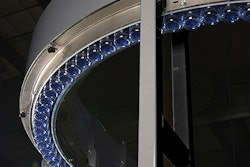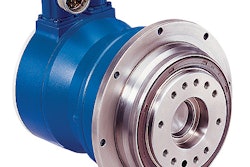For more than 100 years, Mutual Materials of Clackamas, OR, has been manufacturing paving stones and brick, as well as concrete blocks. Two years ago, owners determined that their two packaging lines were responsible for excessive product damage due to pallet load instability.
Both packaging lines, identical in function, consisted of palletizer and stretchwrapper. Product was automatically palletized, and when the pallet was complete, a forklift operator would transport it to a semiautomatic, turntable-style stretchwrapper. From the stretchwrappers, wrapped pallets were taken outside for storage or out the door for shipping.
The problem was, the use of a forklift to move a full, unsecured pallet caused shifting and jostling of the product. This loss of stability often caused product damage. Also, inherent in the turntable stretchwrapper was centrifugal force that caused the bricks to sway outward, away from the center. Again, this caused instability in the pallet load. In all, pallets were moved more than 50 feet by forklift operators.
The semiautomatic stretchwrappers were also incapable of keeping up with the palletizer output. Therefore, forklift operators were placing the loaded pallets in a queue of sorts to wait their turn on the semiautomatic stretchwrapper. This meant that the pallets had to be picked up again from the floor and placed on the wrapper.
Fixing the problem
The solution was to replace one of the semiautomatic stretchwrappers with an automatic stretchwrapper from Orion Packaging Systems (Collierville, TN) to run on one of the palletizer lines. The remaining line with old stretch wrapping equipment functioned as it had before the new installation. Also added was a 15’ stretch of powered roller conveyor leading directly into the new stretchwrapper. This arrangement eliminates the need to use a forklift to transport unstabilized pallet loads from palletizer to stretchwrapper.
Also important is that the new stretchwrapper, a Model MA-55 automatic rotary tower machine, allows the pallet to remain stationary while the film carriage rotates around it. This eliminates the problems that Mutual Materials was having with centrifugal force.
Two other features of the new stretchwrapper are its film delivery system, which pre-stretches the film 245% to reduce material costs significantly, and an upstream top-sheet dispenser.
Not all pallets require a top sheet. Only those that are likely to be stored outside need the added protection. The top-sheet dispenser has a bypass selector switch that allows operators to input the number of pallets that need top sheets. The dispenser counts the loads coming through and automatically dispenses top sheets on the pallets that require them, while skipping the pallets that do not.
Plant manager John Hanson says this is a big improvement over the previous packaging method, where operators had to keep count of pallets to be stored outdoors and manually inserted top sheets.
The top sheet is applied from rollstock. Photo eyes detect the precise position of a pallet as it nears the top-sheet dispensing station. Mechanical grippers pull material from the roll and a hot wire cuts the film at a predetermined spot. This releases the material onto the top of the pallet.
From here the pallet continues on to the stretch wrap station. Photo eyes again detect the pallet position so that wrapping begins at the correct moment. The film carriage goes around the bottom of the pallet first and gradually works its way up, securing the top sheet in place along the way. The carriage then descends, adding additional film on its way down. At the end of the cycle, the film tail is cut and the finished pallet discharges onto an accumulating conveyor where the forklift retrieves them.
Reaping the benefits
“We were so impressed with the first Orion stretchwrapper that we ordered a twin for our other production line and installed it ourselves,” Hanson says. “This is confirmation of their ease of installation and operation.
“We were looking for something that would stand up in this environment,” he continues. “We use steam kilns to cure our products. And we’re here in the Pacific Northwest, so we have a constant relative high humidity. We also have a lot of dust in here.”
Aside from being versatile and rugged, the system also proved cost efficient for the industrial manufacturer. Because of the previously mentioned film delivery system, Hanson estimates they save 15% on each roll compared to the old system.
“Thanks to the new automatic stretch wrapping systems, our product is not handled until it exits the process, wrapped and ready to be put in inventory,” Hanson concludes. “We rely on them to operate in a harsh environment, and they’ve passed with impressive results.” —ALR


























